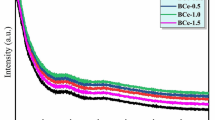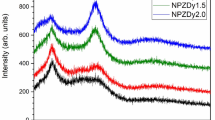Abstract
The paper deals with optical and electronic properties of the aluminophosphate glasses containing Fe–Mn and Fe–Cr ion pairs in different concentration. The influence of the mixed alkali ions over the electronic properties has been investigated. The optical behavior (optical transmission) of the glass samples has been studied by UV-VIS spectroscopy and the refractive index dependency on wavelength has been discussed. The transmission spectra show features specific for the doping transition ions (TM), revealing different oxidation states of iron (Fe2+/Fe3+), manganese (Mn2+/Mn3+) and chromium (Cr3+/Cr6+) in the vitreous network. Mössbauer spectroscopy offers information regarding the TM oxidation states, redox processes and the iron coordination symmetry in the vitreous network. In the case of Fe–Mn doped glasses, the percentage of Fe2+ is about 40% and a doubled iron content leads to an increasing of Fe2+ percentage up to 53%. The replacing of lithium ions by natrium ions (mixed alkali effect) provides an increasing of the Fe2+ percentage up to 56%. The occurrence of the tetrahedral or octahedral symmetry of Fe2+ ions bonded by O2− ions depends on the transition ion nature and Li+/Na+ ratio. Infrared absorption spectra of the pair transition ions-doped aluminophosphate glasses reveal optical phonons specific for the phosphate glass matrix.
Similar content being viewed by others
Abbreviations
- UV-VIS:
-
Ultra-violet-visible.
- IR:
-
Infrared
- EPR:
-
Electronic paramagnetic resonance.
- EXAFS:
-
Extended X-ray Absorption Fine Structure.
- NIR:
-
Near infrared.
- TM:
-
Transition metal.
- RT:
-
Room temperature.
- FT-IR:
-
Fourier transform-infrared.
- PR:
-
Pulfrich refractometer
References
Ardelean I., Cozar O. and Simion V. (1997a). EPR of Mn2+ ions in soda-phosphate glasses. Balkan Phys. Lett., 5: 876–879
Ardelean I., Peteanu M. and Cozar O. (1997b). Magnetic properties of MnO−B203−CdO glasses. Balkan Phys. Lett., 5: 844–847
Brow R.K. and Arens C.M. (1994). An XPS study of iron phosphate glasses. Phys. Chem. Glass., 35(3): 132–136
Elisa, M., Cristiana. E.A., Grigorescu, Cristina Vasiliu, Bulinski, M., Kuncser, V., Daniela Predoi, Filoti, G., Aurelia Meghea, Nicoleta Iftimie, Maria Giurginca: Optical and electronic properties of the aluminophosphate glasses doped with 3d-transition metal ions. Rev. Adv. Mat. Sci. 10, 34–40 (2005)
Glazkov V.I., Golant K. M., Zavoromy Yu. S., Lebedev V.F. and Rybaltovskii O. (2002). Polyvalent states of chromium ions in silica glasses prepared by plasma-chemical deposition. Glass Phys. Chem., 28(4): 201–206
Guomei W. and Jiaheng L. (1991). XPS, IR and Möbauer studies of lithium phosphate glasses containing iron oxides. Submolec. Glass Chem, Phys., SPIE, 1590: 229–236
Haouari M., Ajroud M., Ben Ouada H., Maare H., Brenier A. and Garapon C. (1999). Spectroscopic properties of Cr3+ doped phosphate glasses. Phys. Stat. Solid (b) 215(2): 1165–1177
Haouari, M., Ouada H. B., Maaref, H., Hommel, H., Legrand A. P.: J. Phys. Condens. Matter 9, 6711–6718, (1997)
Kumar B. and Lin S. (1991). Redox state of iron and its related effects in the CaO−P2O5−Fe2O5 glasses. J. Am. Ceram. Soc. 74(1): 226–228
Pascoal H.B., Pontuschka W.M. and Rechenberg H. (2000). Investigation of Fe+3 and Fe+2 properties in calcium aluminoborate glasses. Appl. Phys, A 70: 211–214
Pascoal H.B., Pontuschka W.M. and Rechenberg H.J. (1999). Properties and structural features of iron-doped phosphate glasses. J.Non-Cryst. Solids, 258: 92–99
Reis S.T., Pontuschka W.M., Yang J.B. and Faria D.L.A. (2003). Properties and structural features of iron doped BABAL glasses. Mat. Res 6(3): 389–394
Sales B.C. and Boatner L.A. (1986). Optical structural and chemical characteristics of lead indium phosphate and lead-scandium phosphate glasses. J. Non-Cryst. Solids 79: 83–87
Tsuchiya T. and Yoshimura N. (1989). Electronic conductivity in Na O-FeO-P O glasses. J. Mater. Sci, 24: 493–498
Weinberg B. and Matusovsky M. (1997). Novel fluorine-phosphate semiconductor doped glasses: linear and nonlinear optical properties. J. Appl. 81(10): 6934–6938
Wu X., Yuan H., Yen W.M. and Aitken B.G. (1996). Compositional dependence of the luminescence from Cr4+ - doped calcium aluminate glass. J. Lumen., 85: 66–67
Zotov N., Schlenz H. and Brendebach B. (2003). Effects of MnO-doping on the structure of sodium metaphosphate glasses. Z. Naturforsch., 58: 419–428
Author information
Authors and Affiliations
Corresponding author
Rights and permissions
About this article
Cite this article
Elisa, M., Grigorescu, C., Vasiliu, I. et al. Optical characterization of the phosphate glasses containing pair transition ions. Opt Quant Electron 39, 523–531 (2007). https://doi.org/10.1007/s11082-007-9097-1
Received:
Revised:
Accepted:
Published:
Issue Date:
DOI: https://doi.org/10.1007/s11082-007-9097-1




